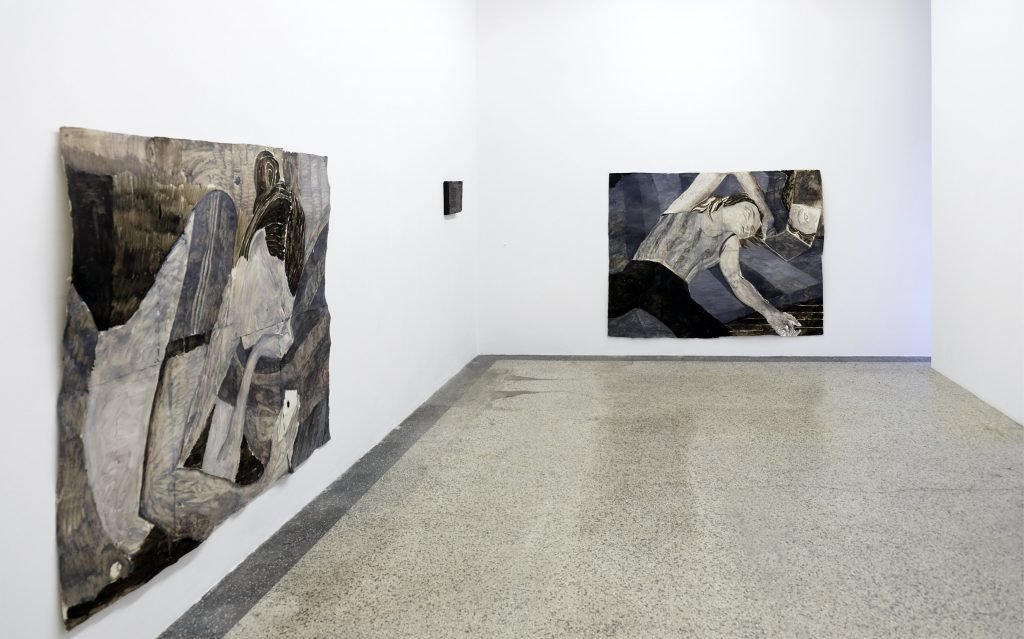
Slow waves
4 Nov. – 22 Dec. 2016
SLOW WAVES
ROBERT BRAMBORA, TALISA LALLAI, ULRIKE SCHULZE
4 NOVEMBER – 22 DECEMBER 2016
We spend around a third of our lives in a state of temporary unconsciousness, going through five stages of sleep. One of them is the so-called ‘slow wave sleep’ – known as the deep sleep phase, in which the brain waves show the slowest activity during the entire sleep cycle. In the group exhibition “Slow Waves”, three young artists individually deal with different phenomena of sleep. Sleep has many facets as an indefinable and incomprehensible space of meaning of the unconscious and subconscious: from a subtle dream world, to a gentle other-worldliness, to disconcerting exhaustion.
Powerless, exhausted and worn out, Robert Brambora’s figures merge with their colourless background. The artist stages the state of exhaustion as an increasing phenomenon of our society with painterly expressiveness. Although the scenes are realistic, some elements refer to the inner life of the depicted persons and allow the viewer to participate. The psychogram does not provide any information about the state of the figures: Half-sleep, boredom, refusal or inertia. Brambora’s paintings show a kind of ‘anti-icons’ to today’s achievement-oriented society. The strength of the refusal is underlined by the genre of painting. Until the end of the 20th century, figurative painting in particular was regarded as outdated and defamed: as a standstill in the history of contemporary art. In addition to the paintings, Brambora’s bog oak objects deal with a contiguous theme: exhaustion and powerlessness through work. In the digital world, this subject area is in great demand for discussion – for example on the well-known blog “Reddit”. Brambora uses these digital and fleeting commentaries on suicidal thoughts, depression and psychological impasses and fixes them materially as engravings on the bog oak plates, thus making them permanent. The transience of the digital gives way and is replaced by the durability and permanence of a kind of tablet of law or a ritual cult object. Brambora analyses social phenomena with a cultural anthropological perspective, and at the same time opens them up for critical examination through his artistic works.
Ulrike Schulze’s whitish plywood works are of poetic sensual quality, seemingly coming from a mysterious world. The rawly processed, puristic works oscillate between the familiar, the foreign and the imaginary dreamlike. At first glance they are related to the tradition of formal minimalism; at second glance they exceed this through the special, delicate and independent handling of material and space. Grace, aggression, fragility and coarseness collide. Through their charisma, the works relate to the exhibition space and become themselves temporary architecture. Conversely, the already existing space is newly captured and perceived. The artist compares this phenomenon with the moment of waking up and falling asleep. Sinking into sleep requires a few minutes of letting oneself in for a gently enraptured state, while the first glance into the real world when waking up causes a disorienting irritation. The works of Ulrike Schulze move between these states. In Schulze’s ceramics, dented and carved areas make the working process visible. During the painting and material process she always finds herself on the threshold between loud and quiet and tries to fathom it.
Talisa Lallai’s intermedial works deal with the dreamy moment of longing by means of a transfigured pictorial language. In the video work You shouldn’t like pink because that’s for girls, the flamingos’ slow, delicate movements lose all sense of place and time. The continuous loop of the Super 8 film format is more of a daintily moving photograph that does not reveal whether the graceful animals were shot in the wild or in captivity, when the recording was made, or what function the recording has. The artist directs her attention to worn motifs of a recurring trend and removes central identifying features. As soon as the striking pink or pink splendour of the flamingos’ feathers turns into faded shades of grey, its special feature disappears. Nevertheless, the animals create a special longing and the charming appearance of a strange, self-sufficient, inaccessible and unobserved foreignness and distance. Lallai’s opaque works are like a shallow pull into a romanticized dream world filled with longing, in which the sense of time and spatial orientation are suspended.
Robert Brambora, *1984, lives and works in Cologne and Düsseldorf, dhcs fellow of the Kunstverein f.d. Rheinlande u. Westfalen; co-curator Bruch&Dallas, Cologne; co-founder of Real Positive. Exhibitions include Museum Kunstpalast, Düsseldorf; Salon Kennedy, Frankfurt; ABC Kolonie, Copenhagen; Kunstverein Wiesen; Weltkunstzimmer, Düsseldorf.
Talisa Lallai, *1989, lives and works in Düsseldorf, exhibitions include: Kunstmuseum Solingen; BolteLang, Zurich; KIT Düsseldorf; Museum Kunstpalast, Düsseldorf; Sies & Höke, Düsseldorf, Coalmine, Winterthur and many more.
Ulrike Schulze, *1985, lives and works in Cologne, 1st winner of the Ehrenhof Prize. Exhibitions include: Museum Kunstpalast, Düsseldorf (2017); Tom, Dick or Harry, Düsseldorf; Bruch & Dallas, Cologne and many more.
All three artists are graduates and master students of the Kunstakademie Düsseldorf in the final class of Rebecca Warren 2015/2016.
SLOW WAVES | GALLERY EXHIBITIONS

4 Nov. – 22 Dec. 2016